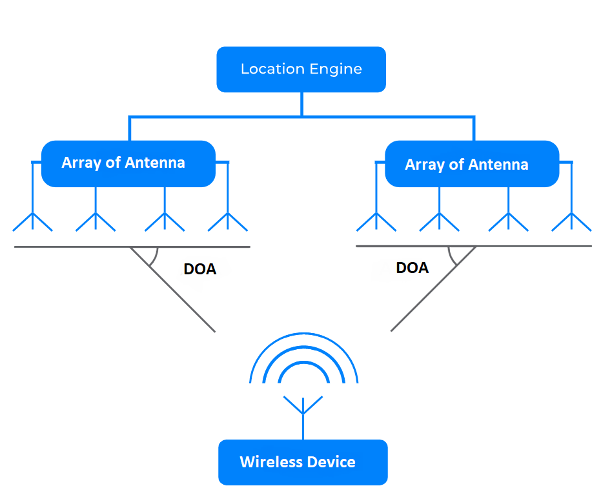Direction of Arrival (DOA) methods are a class of algorithms used to determine the direction of a signal source relative to a receiver. The DOA estimation has a wide range of applications in fields such as radar, wireless communications, and acoustics. In wireless communication systems, DOA techniques are used to locate wireless devices, track moving objects, and avoid interference. In acoustics, DOA techniques can be used to localize sound sources in a room or to track the movement of animals using ultrasonic sensors.

Figure 1: Architecture of a DOA-based indoor positioning system
Specifically in this research, DOA techniques typically use an array of antennas to estimate the direction of arrival of radio-frequency signals. The array geometry, the spacing between antennas, and the number of antennas all affect the accuracy and resolution of the DOA estimates. In the case of indoor positioning systems, the estimation of DOAs is an intermediary step to calculate the position of wireless devices. Figure 1 depicts the main devices in DOA-based indoor positioning systems.
The most popular DOA techniques include MUSIC (MUltiple SIgnal Classification), ESPRIT (Estimation of Signal Parameters via Rotational Invariance Techniques), and beamforming. These methods are computationally intensive and require significant processing power and memory, which can be a challenge for small embedded devices with limited resources. In the context of the manuscript, the authors present a novel DOA method tailored for IoT devices that utilizes the direction-finding capability of Bluetooth. The proposed method is designed for L-shaped arrays with an RF switch and exploits the radio communication system design to speed up execution while minimizing energy consumption and memory usage. The method uses a root-finding algorithm to estimate the DOA without requiring complex arithmetic, which further reduces computational complexity. It computes a fast RF switch compensation that circumvents the inverse of a matrix. The experiments conducted in the manuscript demonstrate that the proposed solution achieves good accuracy and attains an execution time of a few milliseconds, making it a viable solution for DOA implementation in IoT devices.
You can find the full paper at: https://zenodo.org/record/7795014

